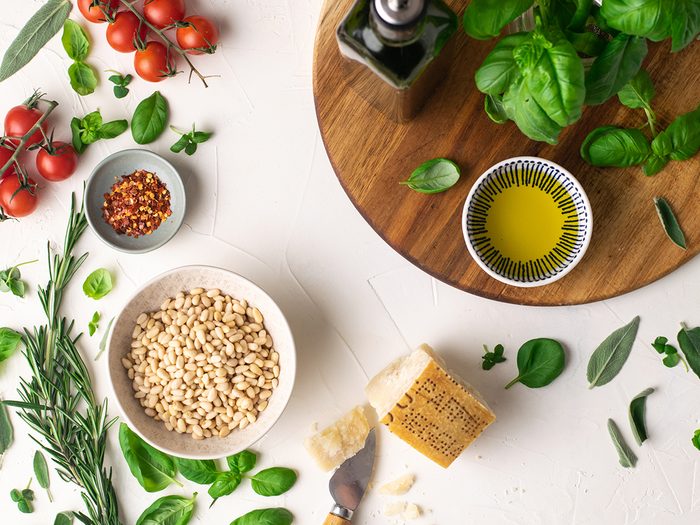Pesto, the Perfect Spring Food—and It’s Healthy Too

Try making pesto with other herbs or veggies for a nutritious spin on the classic sauce.
Pesto is perfect for something I call fridge foraging: using up those random bits in your fridge that need a dish to call home—stat. Ingredients like leftover fresh herbs, a stray bell pepper or the end of a bag of nuts or seeds come to mind. It’s also a nutritious, versatile sauce that will zhuzh up anything you add it to. For traditionalists, pesto is a sacred symphony of basil, parmesan, pine nuts, garlic, olive oil and salt, but try to see this as a jumping off point for a multitude of flavours and combinations. Master the pesto basics, then let your imagination run wild.
(Related: How to Grow Indoor Herbs and Veggies in Any Home)
Think beyond the garnish
Herbs provide the defining flavour in a pesto and, bonus, they’re super healthy. Herbs are actually an extension of the leafy green family, and like other leafy greens, herbs are high in vitamins A, C and K.
Many herbs, like basil, oregano, dill and cilantro, also contain polyphenols—plant compounds with antioxidant and anti-inflammatory properties. Polyphenols can be protective against cardiovascular disease and type 2 diabetes: They may lower blood sugar and help to prevent blood platelets from clumping together, which can create a clot, narrow arteries and cause deep vein thrombosis, stroke and pulmonary embolism.
Sneak in other greens (or beans!)
No herbs? No problem. Using greens like kale, arugula and spinach is a great alternative. Not only will you be upping the nutrient content, it also provides an opportunity to use leftover greens (arugula stragglers, I’m looking at you). Don’t discount the tender greens attached to other vegetables, like beets, turnips and carrots: These are edible and are good candidates for pesto too. You can also add nutrients by blending in other vegetables and legumes, like roasted bell peppers, cooked zucchini, peas or edamame for added fibre and protein.
Keep it fresh
To make a flavourful pesto that will keep well, there are a few key things you should keep in mind. First, make sure you toast your nuts or seeds. Toasting until golden and fragrant heightens their flavour so nuts taste even more buttery and complex. My preferred method is to dry toast in a pan on the stovetop, where I can give them an occasional shake to nudge browning along. Nuts can turn the corner from golden brown to burnt quickly, and it’s harder to keep track when they’re in the oven. Once your nuts are nice and toasty, blitz them together with herbs, grated cheese, seasonings and oil to craft your pesto.
To keep your pesto bright green, use fresh, perky herbs—bruised herbs will lead to murkier pesto. Be sure to pat the herbs dry before use. To prevent browning in the fridge, cover the pesto with a thin layer of olive oil or press plastic wrap against the surface to make a barrier against oxidation. That being said, just because your pesto is more Oscar-the-Grouch green than a vibrant emerald doesn’t mean it won’t be tasty!
Use it on pretty much anything
Go off-script and think beyond basil to unlock infinite possibilities. Try using toasted pumpkin seeds, cilantro and lime juice, then spread it on tortillas to make breakfast burritos or drizzle it over tacos. Make use of the end of a jar of roasted red peppers or sun dried tomatoes: Blend them up with olive oil, toasted walnuts, anchovies and chili flakes for a flavour bomb of a pasta sauce.
Try spreading pesto onto bread for sandwiches or as the base of a pizza. Dot pesto onto the whites of your eggs just after they hit the pan for pesto-laced fried eggs. You can also add easy flavour to proteins like chicken breast or salmon filets by covering them with a layer of pesto just before roasting.
Add a little olive oil or lemon juice to thin out your pesto and you have a salad dressing. Or, stir a bit of pesto into yogurt, sour cream or mayonnaise for quick dip for crudité or to serve with smashed potatoes.
Any way you spread, dollop or drizzle it, pesto helps to make nutritious foods like greens, vegetables and lean meats more exciting. Let the fridge foraging begin!
Laura Jeha is a registered dietitian, nutrition counsellor and recipe developer. Find out more at ahealthyappetite.ca.




